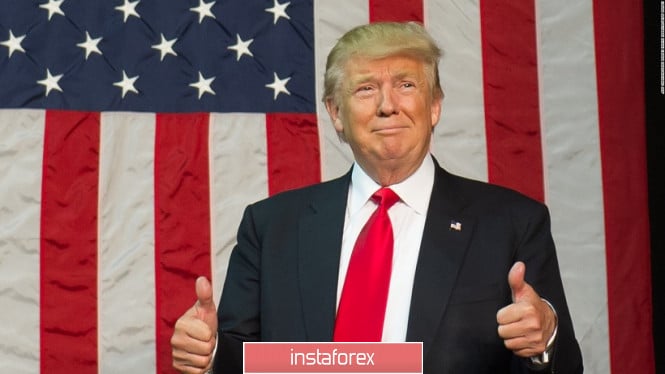The Japanese currency is rapidly strengthening throughout the market: the yen hardly updated its annual low (106.81) paired with the dollar, it also renewed a two-year minimum paired with the euro, and a three-year one paired with the pound. A pair of USD/JPY yesterday fell by 150 points, despite the growth in the dollar index and the overall dominance of the greenback. Today, the southern dynamics of the pair has continued, although not with such intensity - on the eve of the release of Nonfarm many traders take profits. Nevertheless, the yen is still in demand, amid an unexpected increase in anti-risk sentiment.
The focus of the markets – another escalation of the trade war between China and the United States. Donald Trump said on his Twitter yesterday that from September 1, the United States will impose an additional 10 percent duty on almost all Chinese imports (for $ 300 billion): this list of goods does not include those that had already come under a 25 percent charge. It is worth recalling that the first stage of the new trade negotiations, which took place the other day in Shanghai, was completed ahead of schedule. The parties did not comment on its results in detail, having escaped only with formal and veiled phrases about "certain progress". But judging by the fact that the American president announced the new duties to the People's Republic of China the very next day, there is actually no progress in relations between the countries.

However, Donald Trump had not previously been optimistic about the negotiation process - he recently made it clear that the current trade negotiations are unlikely to end effectively. In particular, on the eve of the meeting of delegations in Shanghai, he suggested that the Chinese intentionally pull time, avoiding the escalation of the trade conflict and at the same time, hoping for a change of power in the United States next year. Simultaneously, Trump warned that if the parties did not enter into a trade agreement during the period of his first cadence, then in the period of the second cadence, the transaction would be concluded on more stringent conditions for the PRC or would not be concluded at all. Trump seems to have no doubts that he is being re-elected for a second term, despite the results of recent polls.
It is noteworthy that the refusal of Beijing to resume purchases of American agricultural products became the direct reason for introducing new duties. Let me remind you that at the end of the G20 summit, the parties agreed on mutual concessions - China resumes purchases of agricultural products, and the United States lifts sanctions against Huawei. However, it soon became clear that Washington's relief was more of a formal nature - for example, the Chinese technology giant remained on the "black list" of the Americans, despite certain concessions (in particular, they were allowed to implement certain types of processors). Beijing responded to the situation accordingly - refused to fulfill its part of the agreements.
In addition to the escalation of the trade war between China and the United States, there are several other reasons for the growth of anti-risk sentiment in the market, and accordingly for the further growth of the Japanese currency. Firstly, Japan excluded South Korea from the so-called "white list" of countries with minimal trade restrictions. Now, Japanese exporters need to obtain individual permits for the supply of each batch of their products (and we are talking about a thousand industrial products). Relations between the countries deteriorated after the scandal with the demands of Seoul from Tokyo to pay compensation for the years of colonization of the Korean Peninsula in the last century. And although the news should hit the Japanese currency first, the yen continues to gain momentum due to the demand for defensive assets.
Moreover, according to the American press, Donald Trump will make a statement tonight regarding the prospects for trade relations with the European Union. Obviously, we will talk about the possible introduction of additional tariffs on the import of European cars. Last year, the trade war between the US and the EU was averted, but at the beginning of this year, the situation escalated again. Specialists of the US Department of Commerce prepared and handed over a report on the import of cars to the States from Europe to the American president. Following that, Trump had to make the appropriate decision: to introduce protective duties or not. In May of this year, against the background of the escalation of the trade war with China, Trump did not dare to open the "second front" of the trade war - he postponed the introduction of import duties on European cars for six months, that is, until the autumn. Today, he may intimidate Brussels with barriers again. However, EU trade commissioner Cecilia Malmstrom stated a month ago that if the United States imposes duties on manufactured cars against EU countries, Brussels will respond with its own duties - by 35 billion euros.

Thus, the growth of anti-risk sentiment in the market is fully justified, as is the strengthening of the Japanese currency. If we talk about the technical side of the issue, then the priority is definitely beyond the south. The Ichimoku indicator on the daily chart formed a bearish signal "Parade of lines", in which the price is under all its main lines and under the Kumo cloud. Secondly, the pair is between the middle and lower lines of the Bollinger Bands indicator, which also indicates a downward trend. The nearest downward target (support level) is the mark of 106.15, which corresponds to the bottom line of the Bollinger Bands indicator on the weekly chart.
The material has been provided by InstaForex Company - www.instaforex.com